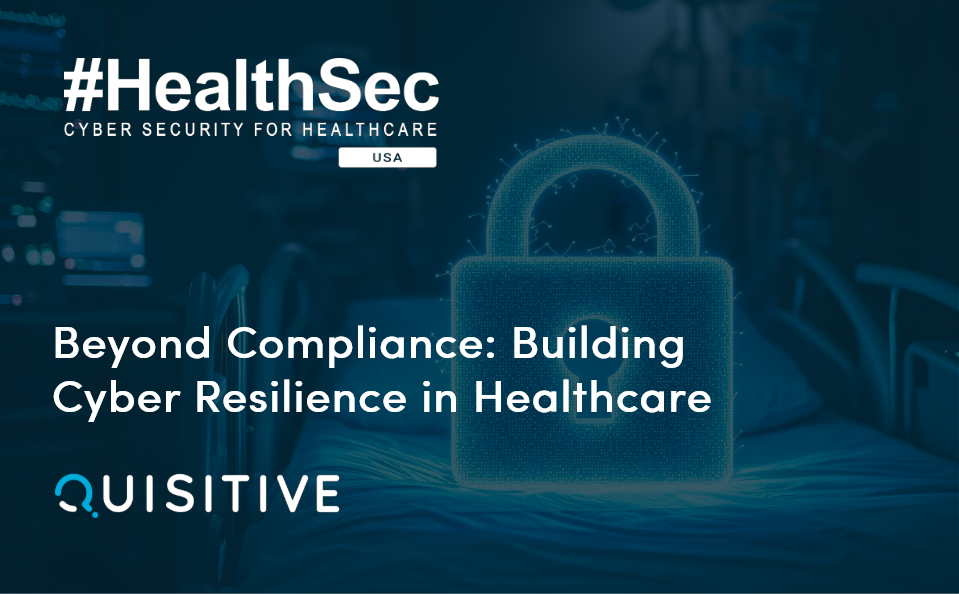Every year, the HIMSS Conference & Exhibition acts as a barometer for the healthcare industry. In mid-March, healthcare chief information officers, technology partners, and thought leaders convened at HIMSS22 for the first time in two years. This year, in Orlando, there was a palpable feeling of reunion, and energy was high as technology leaders shared insightful panels, discussions, and product and partnership announcements.
Quisitive’s very own Pat Becker, Chief Strategy Officer of Healthcare, was in attendance as a guest and demo presenter at Quisitive’s booth in the Microsoft pavilion. In the sections that follow, she shares her top five HIMSS22 takeaways and reflections.
Top 5 HIMSS22 Takeaways
1. Healthcare organizations are prioritizing health equity initiatives and access to care
Stark outcome inequalities emerged throughout the COVID-19 pandemic, which helped spur a national conversation around health equity. The topic was in constant discussion at HIMSS22 and figured heavily into keynote content and healthcare leaders’ strategic priorities.
Under discussion was the role of data and AI in helping to address and minimize health inequalities across America. Government and healthcare organization leaders shared strategies that focused on the collection of accurate and up-to-date patient data, which become critical foundations of any health inequity action plan. The CMS Equity Plan is prioritizing the collection of race, ethnicity, and language (REAL) demographic information. Along with social determinants of health (SDOH), adverse childhood events (ACEs) and other screeners, organizations can help develop culturally relevant and community-centric care plans, and help equip providers with relevant information to aid during visits. Quality and population health leaders can leverage organization-wide data to help identify broad gaps in care trends and drive actionable insights that can help identify and reduce disparities.
2. The healthcare at home movement is rapidly maturing
Moving the site of care homeward has long-promised benefits both to healthcare systems, but also to patients – helping to boost satisfaction while saving organizations money. Accelerated by the pandemic, and further driven by the increasing consumerization of healthcare and renewed interest in value-based care contracting and population health management, the movement enables patients to access care anytime, anywhere. Remote patient monitoring solutions that integrate seamlessly with the organization’s EHR are key, as are reliable and secure virtual care solutions that can easily connect patients and providers.
While lingering uncertainty remains among both physicians and healthcare organizations due to piecemeal reimbursement legislation, systems must be prepared for the growing consumer expectation.
3. Behavioral and mental healthcare are central to overall wellness
Covid-19’s long-term impact on behavioral and mental health will continue to manifest. Social isolation and loneliness have taken a deep toll, and according to U.S. Surgeon General, Dr. Vivek Murthy, we’re currently experiencing a “national youth mental health crisis.” Since the pandemic’s onset, the national conversation around mental health has blossomed.
This year’s event was no exception. Among attendees, there was a new general consensus that behavioral healthcare and physical healthcare are intimately intertwined. For patients, that means organizations are considering new ways to provide integrated care that will help remove silos and redefine “holistic healthcare” in a whole new way. For organizations, rising levels of provider burnout and clinical stress are challenging workforces and their ability to provide high levels of quality care.
4. The healthcare cloud is growing
Connections happen in the cloud. At HIMSS, leaders discussed the rise of the cloud and the benefits of migrating systems to support patient-centered, collaborative care. At the Microsoft Cloud for Healthcare booth, the conversation centered around improving the patient experience and leveraging data interoperability to empower clinicians at the point of care. The solution is built to boost patient engagement, empower clinical team collaboration, prioritize sensitive patient data security, activate data for actionable insights, and drive seamless data management for clinical and operational insights.
Built on Azure technology, the health cloud leverages data services to easily unite in-person clinical workflows, with images and screenings, medical devices, and more. The company is building out its Teams product to better support the adoption of telehealth, including virtual care visits and seamless integration with the largest EHRs.
5. AI and machine learning will power advances
Artificial intelligence-driven predictive models and screenings will help generate new efficiencies with applications that will reverberate across the industry. Faster methods of data entry, ingestion, and sharing can help advance interoperability while alleviating the manual burden on existing staff, which could help moderate the clinical burnout crisis and pervasive workforce shortage.
On a macro scale, predictive models can also be applied to emergency forecasting that will enable systems to prepare in advance of any future pandemics or infectious disease outbreaks. Attendees acknowledged that gaining broader patient-consumer trust around AI, natural language processing, and other machine learning techniques will be critical for the technology’s continued adoption and long-term use.
Towards a more connected future
Overall, this year’s event was both a reunion celebration and a resetting of priorities for the rapidly evolving healthcare landscape. While reconnecting in person, themes of connection overall resonated throughout keynotes, demos, and discussions. Building greater and faster means of connection is key, from greater inclusion in healthcare to reducing stigma around mental health, and incorporating a broader set of patient demographic data to help expand equal care and coverage.
Underneath it all ran a common theme: technology will help improve outcomes by creating new means of connection and collaboration. From telehealth and healthcare at home to seamless data integration across the cloud and EMRs, and the potential of AI to expedite critical population health initiatives, technology promises the healthcare industry a means of providing patients equal, safer, and better care.

;)



